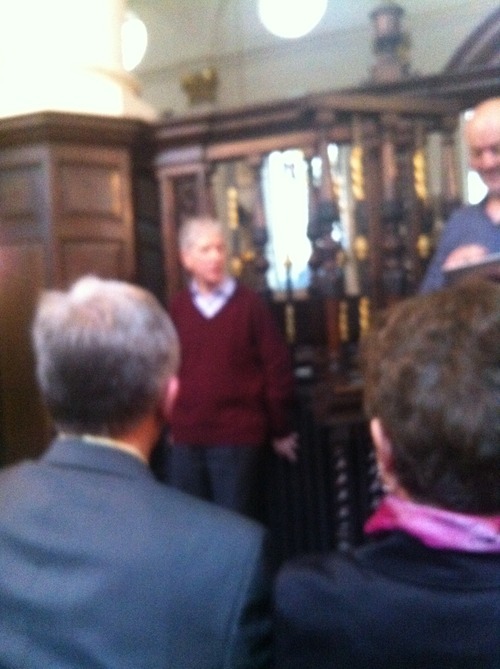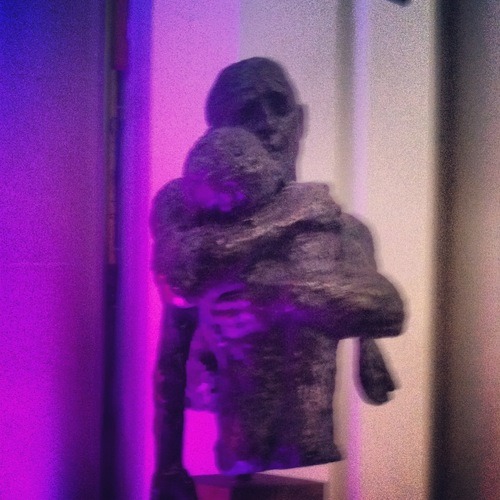A Prodigal Visual Ethnography of London
Introduction
Pink argues that Visual Ethnography should entail a personal, subjective and reflexive orientation.[1] As such, I have chosen to present a personal visual ethnography of London that intersects with my research and ministry interests and the concepts that I have recently learned in DMIN 737 elucidated by photos I personally took while participating in the London advance.
Personal Interest
The opportunity to participate in the London Advance was particularly important for me because it intersects with much of my life’s ministry: reaching postmodern, post-Christian culture in the Western world. Spending time in a global yet Western city brought much of this interest together, as we were able to see the shifts and contrasts between the traditional and the emerging, in a British yet global setting. We were able to experience the age old institutions like St. Paul’s Cathedral and Loyd’s of London contrasted with rich and rapid cultural transformation of a global city found in the Indian food we ate, and the multi-cultural boundary pushing imagination of Steve Chalke. From a sensory ethnographic experience, the diverse flavors and smells that permeate London are manifold[2]. I sampled Indian, Vietnamese, Lebanese and even a Scottish haggis. Much like my adopted home country of Spain, the tensions can be dizzying and present key questions of how one is to lead in this postmodern milieu.
Specifically, I was excited to attend Holy Trinity Brompton, and came away with the sensation that they might actually be doing a good job of embracing the tension between old and new, local and global, traditional and emerging. Moreover, I enjoyed HTB because of past ministry experience with the Alpha course. My wife helped to direct Alpha in Dallas for about 5 years, and I was often involved. In our transition to ministry in Spain we have continued to use Alpha to reach Spanish university students. Thus, attending HTB was a great encouragement to see that Alpha and HTB are continuing to impact lives and live out their values in a postmodern context. In last September, during the Advance, a new Alpha Course was getting ready to kick off. We heard testimonies of a wide array of people who had come to faith through Alpha, including a former drug-addicted homeless man who was now counseling youth. Folk musician King Charles sang a cover of Bob Marley’s “Redemption Song,” and the sermon was given by artist Charlie Mackesy, focusing on his artistic and spiritual process for creating a sculpture of the Prodigal Son. All of this of course is done deeply rooted in Anglican theology (and an appreciation for the visual and beautiful) and ecclesiology, yet with an obvious influence from the Pentecostal movement that emerged into the mainline churches through the Charismatic branch. The architecture and setting alone remind of the traditional and even the epoch of European Christendom, for me this was even highlighted by the plaque on the wall commemorating the death of church member in 1866 by shipwreck. Yet, the crowd was decidedly multicultural, non-English, and post-Christendom, filled with Asians, Africans, and internationals.

A damn fine tombstone

We sampled flavors from all over the world, but traditional haggis was my favorite. Even with the explosion of multicultural London, local and traditional flavors still persist. Glocal cuisine?
New Knowledge, Practice, and Application
One concept that stuck with me the most from the Advance came during our time with Rev. Jeremy Crossley. He did an excellent job showing the flexibility needed for the church to minister in a global, over connected world by faithfully incarnating the gospel in the London financial district, and also finding creative and flexible ways to contextualize the church for business people. Both Bauman’s Liquid Modernity and Castells’ The Rise of the Network Society sprang to mind here, as the global, consumerist, capitalist paradigm has altered our lives and relationships.[3] This is of course an ongoing struggle in trying to reach European students, trying to find the right balance of contextuality, flexibility and faithful incarnation. However, what struck me the most was his insistence that business people very much needed the care and love of the church. Moreover, his assertion that perhaps the church in England was once again finding confidence in the gospel was important. I believe that in Europe there has very much been a crisis of the gospel. We experience this in Spain, by the primarily post-Christian orientation, and a general exhaustion and resentment towards the institutional church that pervades much of the culture. This makes evangelism and mission difficult, and at times almost impossible, as it is hard to find the relevance of the gospel to connect to a society that has moved on. When most of society rejects Christianity out of hand, it can be hard to continue to see the importance or even the power of the gospel. Perhaps Crossley is correct, we need to rediscover a confidence in the gospel to impact and transform all walks of life.
Also, the talks by Martyn Percy and David Male were helpful in thinking through the tensions between a more traditional approach to ministry and the need for creating new pioneering and innovating leadership for reaching a resistant culture. It is almost certain that leading in the West will need to strike a careful balance between traditional pastoral ministry based around historical ecclesiastical structures, but also apostolic missional creativity. Here Male’s introduction to the Fresh Expressions movement was particularly helpful in thinking about my context in Spain, where the culture finds itself on one hand in need of apostolic innovation, but on the other hand, still very much connected to a Spanish Catholic culture. Fresh Expressions literature talks of the need for a mixed economy, in providing a diversity of Christian expressions. This has been particularly helpful in thinking through our ministry in Spain, where our staff struggle with this balance. Many see so little value in the institutional church that they can be off putting to those who still want a more traditional type of Christian experience tied to the Catholic Church. This time in London, and some research through the Fresh Expressions and Mission Shaped literature, and has helped me think through how to challenge and work through this tension with my co-workers.

At the British Museum. An infinite pattern with no starting point or ending point. Our world looks more like this; global, network, liquid, connected, complex.
Synthesis
As I synthesize the advance and the course readings together, I come to the question of how does one lead in a liminal world? What leadership skills and themes are necessary for leading Christian churches, mission, and organizations in our emerging reality? I borrow the term liminal from Roxburgh and his discourse of Turner’s book The Ritual Process.[4] Liminal describes the disorientation that one experience while passing through a ritual or rite of passage. Moreover, it can be used to describe political and cultural changes in which new movements or institutions emerge.[5] Certainly what we have in the west is a liminal situation. Change is rapid. The church faces rapid globalization, postmodernization, pluralization, and post-colonial pressures. Christendom is collapsing. Confidence in institutions and the received history of Europe and it’s modern run for progress, domination, and power has collapsed. I turn here to the British Museum, a repository for all of the world’s great cultural treasures, a high symbol of colonialism and Christendom. It now sits in one of the most multicultural cities in the world. Once a center of Christian mission, London now is home to Hindus and Muslims, as well as city buses advertising gay-rights and atheist campaigns. What is more, certainly many mourn this collapse of Christendom, and the pluralization of society. However, this mourning goes too far, and is based only in a sorrow of loss of privilege at best, and an attitude of victimization at worst. Roxburgh is helpful here, he sees the church caught in the liminal world as entering a rite of passage, passing into the margins to then re-emerge and reintegrate into society with a new identity.[6] As such, this time of change and uncertainty is an opportunity for growth, maturity, and above all for the church to rediscover its essence in the Mission Dei as the sent people of God (John 20:21). However, Roxburgh warns: “[t]his kind of reintegration is possible only after the liminal has been accepted as a marginal experience that leads to a new, transformative relationship with the social structures and culture.”[7] Perhaps this sensation mainly strikes at the heart of the traditional and institutional church built on modern age, around polity and tradition. Perhaps Global Pentecostalism is an example of the emerging global church that can offer solutions to Western Christianity in the face of liminal disorientation. Miller and Yaamamori make this case by stating “the hallmarks of renewal movements are that they encourage direct experience of the holy, they break with hierarchial authority, they democratize organizational structures and encourage lay participation, they privilege experience over theological dogma and they typically get attacked by people involved in institutional religion that are threatened by their entrepreneurial spirit.”[8]

Blue chicken vs. tradition. Who will win in the liminal world? Or does it even matter? What emerges from postmodernism? Late modernism, hyper-modernism, or just nihilism?

The mummy’s curse. A crumbling empire houses the treasures of a disappeared empire. After Christendom what? What type of West will emerge? What type of Christianity will survive the liminal process? Will the faith of the former colonies bring renewal and liberation to the West?
Thus, what type of leader is needed for this context?
Lead Visually. It is a visual world, even more so in the postmodern turn, but it has always been a visual world. Dyrness shows contemporary Protestant Evangelicalism has often eschewed the use of art, and visual imagery in worship, through the Reformation in reaction to Catholic imagery elevated word over image.[9] Of course, more recently Protestant evangelicalism has been more tied to the quantifiable, scientific, and often coldly rational modernist mindset. Mystery and beauty were often banished from the church replaced by functionality. But, Morgan explains that the world is imbued with visual images that show “the powerful and pervasive ways in church the devout see the world, organize and evaluate it, and infuse into the appearance of things the feelings and ideas that make the world intelligible and familiar to them.[10] Images can carry meaning and feeling and enhance our worship of God, and our communication of truth. Time spent in St. Paul’s Cathedral and Holy Trinity Brompton highlighted a more Anglican (less removed from Catholicism) robust theology of image, mystery, truth, worship, and beauty. Particularly, artist Charlie Mackesy’s combination of a sermon around his own sculpture of the prodigal son at HTB was an excellent example of communicating worship, truth, and devotion through the visual arts. This is more important within the postmodern shift, where image, symbol, surface have the chance to recover Christian meaning. Christian leaders will need to be able to practically use the visual to communicate while also infusing ancient truth back into Christian images which have lost their significance.

Ancient-Future Beauty

We do sick graphics. Image, art, beauty, and marketing are essential in the postmodern world. Are we communicating Christ to others in the postmodern lengua franca? What kind of sick graphics would Jesus make?

Alpha is not afraid to communicate and market visually and relevantly.
Lead Globally. Kets de Vries makes the astute point that leadership today requires a strong awareness of the global, interconnected, but above all multi-cultural world[11]. I work in a context leading teams of Spaniards, Americans, Latin Americans, and a Lithuanian. This is our global Christian reality particularly in world missions, where Escobar has already opened the Pandora’s Box by defining missions as “from everywhere to everyone.”[12] Here Kets de Vries centers on the need for global leaders to be essentially, anthropologists. They must understand culture, and not only the cultures of others, but their own as well. Ultimately, a global leader will know how to bring teams of varying cultures together creating “a cooperative blending of elements from various cultures” [13] This means that global Christian leaders must have a working philosophy of anthropology and culture. They must be able to accept, enjoy, and blend the flavors and smells of an international world.

It is a global Christian movement, in a global world.
Lead Openly. Bauman’s imagining of liquid as a metaphor for changes in late modern society is apt as one looks at how traditional institutions, structures, and relationships have been redefined. This is essentially the main thesis of Li’s book Open Leadership: How Social Technology Can Transform the Way You Lead.[14] Li goes on to explain that what was once prized as effective leadership and institutional acumen was “control.” The world has shifted to a place where control is almost impossible to maintain and where customers and employees expect a greater sense of collaboration and sharing that goes way beyond the inner circle of organizational leadership. Li explains that successful leaders and organizations will be able to find the perfect blend of openness and control for their specific situation and context. The heart of the book is in explaining the key character and heart changes that must take place in an organization for openness to occur: “In order to be open, you need to let go of the need to be in control. But to fill that void, you need to develop the confidence- to develop the trust- that when you let go of control, the people who you pass the power will act responsibly.”[15] Christian leadership in a liminal world must understand the liquid and networked nature of society, and must work to create openness and transparency from within and without.
Lead with Missional Courage. Courage is needed to lead the church through the liminal world, as the seismic shifts move the church to a disestablished state. This is creating much consternation, fear, and timidity within the Western church, as people try to hang on to structure and institutions. In reality opportunities for the future abound. Friedman in A Failure of Nerve explains to break through the gridlock we need leaders with the nerve to stand up and set a new course, they must take responsibility for their own mission and vision, often in the face of offending others, and create new maps and paradigms.[16] In a sense, they must by being emotionally mature and develop, become the emotional antidote to the cancer of anxiety, allowing others to break through their own gridlocked emotional barriers. Friedman concludes that a gridlocked organizations need a leader with the nerve to emotionally shake people from their anxiety, and recapture a sense of adventure as opposed to fear. Here societies, families, and organizations can once again flourish.
We have seen how Christian organizations and churches exhibit the dysfunctional anxiety that paralyzes. Moreover, the crisis of Christianity in the West seems to be at an all-time high. Many denominations and churches are facing organizational death in the face, all the while maintaining an almost psychotic stance of denial, rooted in fear for their own safety and comfort, instead of seeking the new paradigm. These churches and organizations have in fact lost their nerve and sense of adventure. Some even carry a sense of historical Western guilt that paralyzes them because they don’t want to offend. Could mission help us in the West recapture our nerve and sense of adventure, thus reigniting a vibrant and healthy face among us? Anglican church planter Martin Robinson asserts that “the church is what happens when the followers of Jesus meet together to engage purposefully in mission.”[17] Could it be that the antidote for staid churches who can only worry about preserving their structure and past, are brave leaders with nerve and self-differentiation, unafraid of offending the anxious, whom can re-create the paradigm of a spirit of adventure, vibrancy, and mission. Perhaps a missional ecclesiology can rebirth the church anew. Having passed through a time of pilgrimage, or wandering in a dry place the church will re-emerge in maturity and clarity of purpose, to be the sent ones of God.

Jeremy Crossley. A courageous leader and a mission in the midst of London.
Conclusion
Ultimately, I want to return to the image of Charlie Mackesy’s sculpture of the prodigal son. Perhaps this image best explains contemporary Europe (both nominal and pagan) and its relation to God and the church. It is a people caught in a liminal world of rapid change and societal and philosophical upheaval. People are wandering about looking for something, only knowing they must reject their past (rightly or wrongly), but the emerging culture with its smashing of institutions and pastiche of plurality ultimately offers very little stable ground. Lostness, fragmentation, and dislocation from relationship and meaning are part and parcel of the liquid, liminal world. The image of the rebellious son, wandering in a strange land, with no food, and no shelter springs to mind. Yet, the father waits patiently for return, ready to embrace, and re-embrace the prodigal once again in manifold joy and love. Ultimately, as leaders in a liminal world, we must help the church become the phsycial embrace of God’s merciful love to a prodigal culture. Mackesy’s work is powerful here. The image of a loving father, with his arms wrapped tightly and face aching with love, grasps the prodigal, his body limp from mental and spiritual exhaustion, only needing to fall into those arms. Perhaps the embrace is just as much for a Western church caught up in its own power and comfort, as it is for the lost.

“The Prodigal Son” by Charlie Mackesy
[1] Sarah Pink, Doing Visual Ethnography: Images, Media and Representation in Research (London: Sage, 2007), Kindle, loc 493-503.
[3] Zygmunt Bauman, Liquid Modernity (Cambridge, UK: Polity Press, 2012). And Manuel Castells, The Rise of the Network Society (Malden, MA: Blackwell Publishers, 1996).
[4] Alan J. Roxburgh, The Missionary Congregation, Leadership & Liminality (Harrisburg, PA: Trinity Press International, 1997). And Victor W. Turner, The Ritual Process: Structure and Anti-structure (Ithaca, NY: Cornell University Press, 1977).
[5] Bjørn Thomassen, “The Uses and Meaning of Liminality,” International Political Anthropology 2, no. 1 (March 3, 2009).
[8] Donald E. Miller and Tetsunao Yamamori, Global Pentecostalism: The New Face of Christian Social Engagement (Berkeley: University of California Press, 2007), Kindle, loc 2595.
[9] William A. Dyrness, Visual Faith: Art, Theology, and Worship in Dialogue (Grand Rapids, MI: Baker Academic, 2001).
[10] David Morgan, The Sacred Gaze: Religious Visual Culture in Theory and Practice (Berkeley: University of California Press, 2005), Kindle, loc 4276.
[11] Manfred Kets de Vries, The Leadership Mystique: Leading Behavior in the Human Enterprise (Harlow, UK: Pearson Education, 2006), 174-193.
[12] Samuel Escobar, The New Global Mission: The Gospel from Everywhere to Everyone (Downers Grove, IL: InterVarsity Press, 2003).
[14] Charlene Li, Open Leadership: How Social Technology Can Transform the Way You Lead (San Francisco: Jossey-Bass, 2010), Kindle.
[16] Edwin H. Friedman, A Failure of Nerve: Leadership in the Age of the Quick Fix, ed. Margaret M. Treadwell and Edward W. Beal (New York: Seabury Books, 2007).
Leave a Reply
You must be logged in to post a comment.